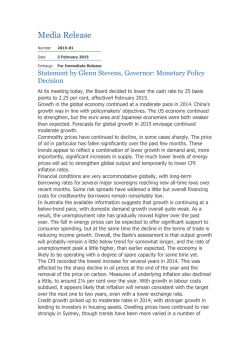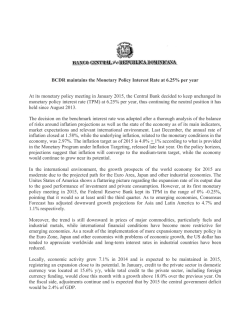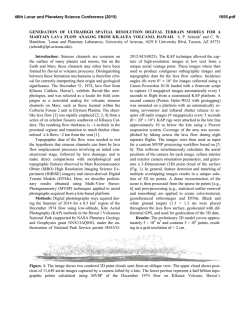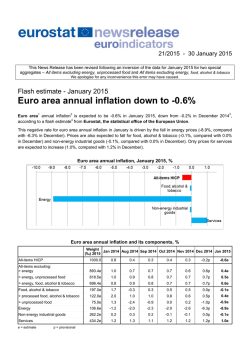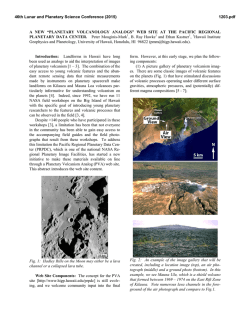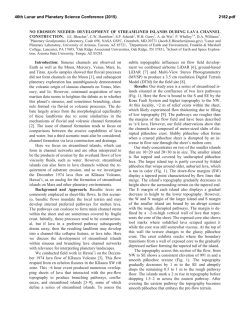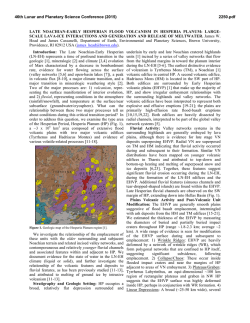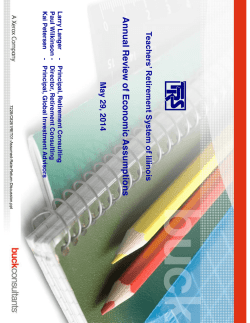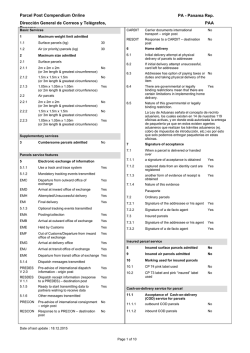
The Role of Cooling in Pahoehoe Emplacement on Planetary Surfaces
46th Lunar and Planetary Science Conference (2015) 1174.pdf 1 THE ROLE OF COOLING IN PAHOHOE EMPLACEMENT ON PLANETARY SURFACES L. S. Glaze , S. M. 2 1 Baloga , NASA Goddard Space Flight Center (Code 698, Greenbelt, MD 20771), [email protected]) Proxemy Research (2052I8 Farcroft Lane, Laytonsville, MD 20882 [email protected] 2 Introduction. Abundant evidence is emerging that many lavas on Mars were emplaced as slow-moving pahoehoe flows (Figure 1). Models for such scenarios contrast sharply with those for steep-sloped applications where gravity is the dominant force. The mode of flow emplacement on low slopes is characterized by toe formation and inflation [1-7]. In the latter phase of pahoehoe flow emplacement, stagnation, inflation, and toe formation are most closely tied to the final topography, dimensions, and morphologic features (Figure 2). This mode of emplacement is particularly relevant to the low slopes of planetary surfaces such as the plains of Mars, Io and the Moon. Figure 1. Numerous flows on Mars show evidence of inflation, similar to terrestrial pahoehoe flows [8]. The fundamental difficulty in developing a new model for pahoehoe lava flows is that random effects associated with inflation, internal fluid pressure, and crustal strength dominate the emplacement [1-10]. Baloga and Glaze [4] developed an initial 2dimensional model based on classical uncorrelated and correlated random walks [11]. They showed that for simple lobes, the tendency for channel development Figure 2. Terrestrial pahoehoe showing randomness in toe unit directions and orientations. and similar features broadly agreed with field observations. Glaze and Baloga [10] presented a more comprehensive model that simulated random transfers of individual lava parcels as a function of space and time. The output was 3-dimensional topography showing how the lobe thickened and expanded with time subject to a variety of factors such as the source geometry and flow rate. Of particular interest was rate of inflation, i.e., the rate of thickening at the expense of expansion at the margins. Temperature-dependent Simulations. The explicit cooling of surface parcels and the influence of internal inflation pressure have been added to the model of Glaze and Baloga [10]. The three types of simulations described here are referred to as “equiprobable” (as in [10]), “temperature-dependent”, and “pressure-dominated” respectively. All simulations are done on a flat pre-existing surface with a constant rate of lava supply. Each parcel volume is equal to a typical pahoehoe toe (see [9, 10]). Ultimately, the mechanical strength of the crust controls the movement of lava within the lobe and at its margins. The surface temperature is taken here as a proxy for the mechanical strength of the crust. The surface cooling rates of pahoehoe lavas are well known, both from theoretical and empirical studies e.g., [2,12-14]. The equiprobable transfer rules in [10] have been modified to increase the probability when the surface temperature is relatively high and decrease transfer probabilities for cooler parcels. Mathematically, the probability that basal location j at time t is the site of the next lava parcel transfer is Pj (t ) = T j (t ) ∑ T (t ) (1) i i where Tj(t) is the temperature of the surface at location j and the i summation is taken over all occupied basal locations at time t. Once the location for the lava transfer has been determined by (1), the algorithm treats the four possible directions for the lava transfer as equiprobable. The simulations assume that a parcel of lava begins to cool when a cell is first occupied and thus exposed to the atmosphere. Other parcels transferred to that location inflate the volume at that location with the original surface cell continuing to cool according to the empirical formula, (2) T (t ) = −60.8ln(t ) + 303 where t is measured in hours and T is given in ºC [2]. Internal transfers only inflate the lobe locally and leave the pre-existing crust undisturbed and continuing 46th Lunar and Planetary Science Conference (2015) to cool. Heat is propagated through the crust very slowly [12-14]. Thus, it is assumed that only the surface parcels (20 cm thick) cool to any significant degree. Interior parcels remain at a constant temperature (~1150ºC) until they break out into an unoccupied cell at the existing margin of the lobe. The initial surface temperature of a breakout at the margin is set to 1150ºC no matter when it occurs in the simulation. Subsequently the breakout parcel cools according to (2) (Figure 3). 1174.pdf faces. The simulations show that the cooling of individual surface units has little influence on the morphology and dimensions of a lobe. Specifically, the temperature-dependent and equiprobable simulations are unlikely to be distinguishable even in the field for terrestrial analogs. However, when inflation is present, the units take on a marked lobate character that should be readily distinguishable in the field or in plan form planetary images. It is noteworthy that the rate of inflation is virtually indistinguishable whether the cooling of surface units is ignored, considered, or combined with inflation pressure within the lobe. Future studies based on HiRISE topography of flows shown in Figure 1 will attempt to interpret the story of their emplacement in terms of these simulations. Figure 3. Pahoehoe surface cooling curves adapted from [2] and [14]. Arrows indicate time step nunbers, where the parcel from time step 1 has the lowest surface temperature. The general topography and morphology of the temperature dependent lobes is tightly clustered near the origin as in the equiprobable case [10]. Surface parcels cool so rapidly that most parcels are on the long flat end of the cooling curve and thus have roughly the same probability of a transfer. Pressure-Dependent Simulations. When there is an internal lava transfer, the lobe thickness at that location increases. This local inflation increases the fluid pressure at all connected fluid locations within the lobe. The most recent margin breakout location would have the weakest confining mechanical strength. Consequently, when there are one or more internal transfers that cause inflation, the model forces the next transfer to occur at the last margin breakout. The inclusion of inflation pressure in this way has a dramatic effect on the morphology and dimensions of the lobe particularly its maximum length (Figure 4). Simulated lobes are much more elongated than either the equiprobable or temperature-dependent lobes. The total volume of all types of simulations has been fixed so that the greater length of these lobes results in a thinner overall thickness [10]. Despite the changes in lobe shape, the lobe volume attributable to inflation is essentially the same in all three types of simulations. Conclusions: These three types of simulations provide a physical basis for interpreting the final stages of pahoehoe flow lobes on planetary and terrestrial sur- Figure 4. Pressure dependent simulations illustrate elongate lobe structure in plan-view. “X” indicates the simulation origin. Note warmer surface parcels at the flow front. References: [1] Rowland and Walker, Bull Volc, 52, 615-628, 1990; [2] Hon et al., Geol Soc Am Bull, 106, 351-370, 1994; [3] Keszthelyi et al., Geol Soc India, 43, 485520, 1999; [4] Baloga and Glaze, J Geophys Res, 108, 2031, 2003; [5] Harris et al., Bull Volc, 70, 1-22, 2007; [6] Keszthelyi et al., J Geol Soc, 163, 253-264, 2006; [7] Hamilton et al., Bull Volc, 75:756 2013; [8] Wood and Zimbelman, LPSC, 2014; [9] Crown and Baloga, Bull Volc, 61, 288- 5, 1999; [10] Glaze and Baloga, J Volc Geophys Res, 255, 108-123, 2013; [11] Chandrasekhar, Rev Mod Phys, 15, 1-87, 1949; [12] Harris and Baloga, Geophys Res Lett, doi:10.1029/2009 GL0397172009; [13] Crisp and Baloga, J Gephys Res, 95, 1255-1270, 1990; [14] Wright et al., Geology, doi:10.1130/G32341.1, 2011.
© Copyright 2026
